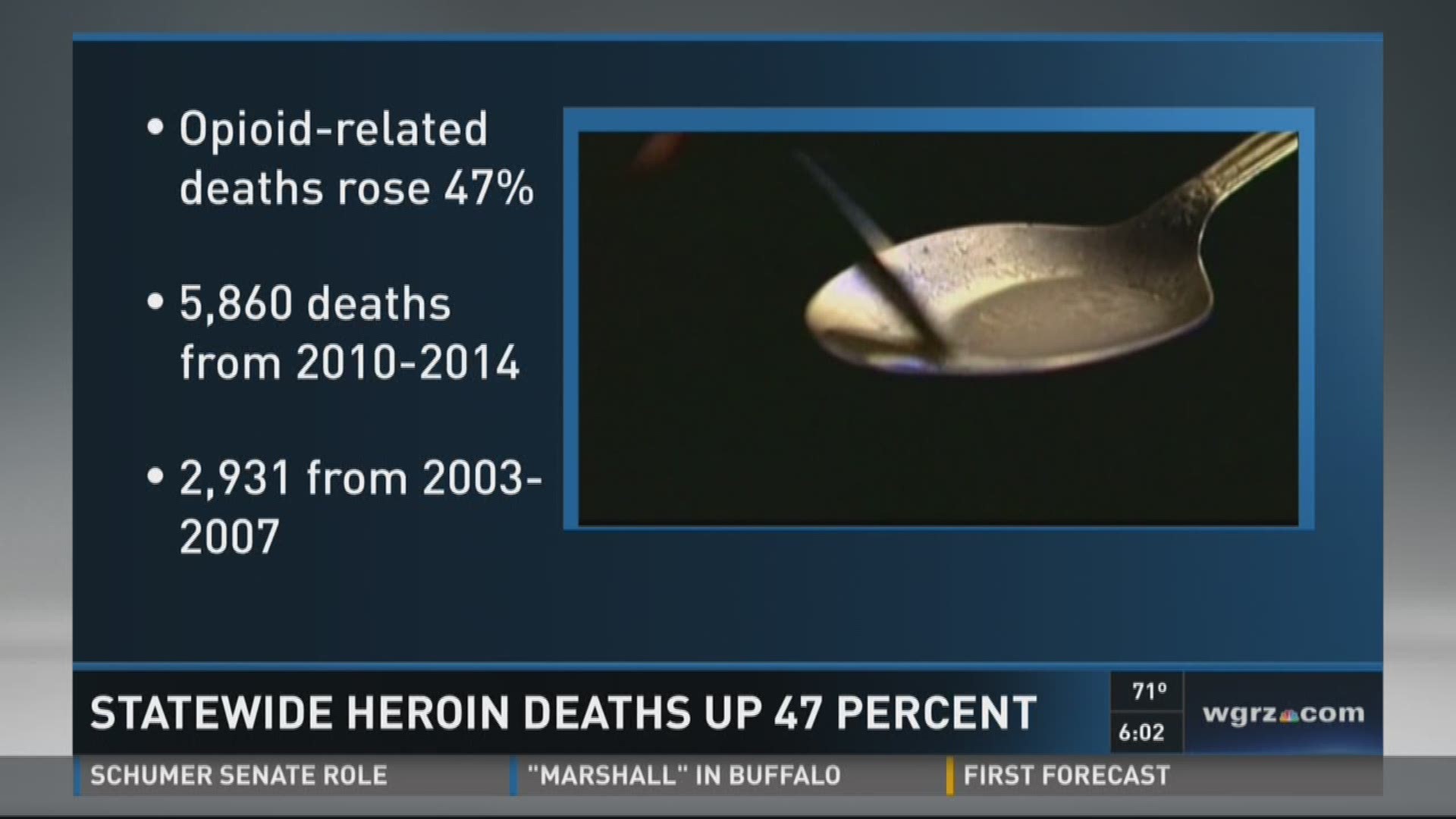ALBANY – The number of opioid-related deaths rose 47 percent in New York between 2010 and 2014, fueled by a surge in heroin abuse, state records show.
The growth in heroin deaths in New York is part of a national trend, but new statistics from the state Health Department just how stark the problem as become across the state, particularly outside New York City.
Indeed, 26 counties of the state’s 62 counties saw the number of deaths double during the five-year span. A total of 5,860 deaths occurred in New York between 2010 and 2014, compared to 2,931 from 2003 through 2007, a review of the data by Gannett’s Albany Bureau showed.
“Opioid addiction is a national epidemic that continues to plague families in communities across New York,” Gov. Andrew Cuomo said May 10 when he announced a new drug task force.
The state Legislature is debating over a package of new bills to address the growing problem before the legislative session ends in mid-June.
A report quietly released by the Health Department this month shows how staggering the heroin and opioid problem has become:
-- Heroin- related deaths in New York reached 637 in 2013 – a 163 percent increase from 2009.
-- The percentage of drug-related drugs involving heroin rose from 16 percent in 2009 to 29 percent in 2013.
-- Naloxone, the heroin antidote, was administered during 12,000 emergency calls in 2014, up a whopping 57 percent from the previous year as it became more available.
-- Opioid-related emergency department visits increased 73 percent between 2010 to 2014.
-- Heroin deaths among young people has skyrocketed: Half the deaths in 2013 were among people under 35.
Deaths per day
The numbers are staggering in some places across New York: In 2013, an average of two New Yorkers a day died of heroin-related overdoses, the Health Department’s report said.
The highest rate of heroin-related overdose fatalities from 2009-2013 in counties with 20 or more deaths was in Dutchess County – at a rate of 5.5 per 100,000 people. Suffolk and Bronx counties were ranked second and third.
Ten counties had a rate of more than 10 deaths for all opioids per 100,000 population in 2014, well exceeding the New York average of 6.7 opioid deaths per 100,000 people, Gannett’s review found.
Sullivan County in the Catskills had 20 deaths per 100,000 people, while Dutchess and Tioga also ranked in the top 10 at 10 deaths per 100,000 people.
“Horror story after horror story that we have heard going around New York state is unacceptable to allow this to continue to happen,” said Sen. Terrence Murphy, R-Yorktown, Westchester County.
Dutchess had 256 deaths from opioids – which include painkillers – from 2003 through 2014.
But the county saw a decline in recent years: from 37 in 2013 to 30 in 2014, which are the most recent statistics available.
Suffolk County on Long Island led the state with 1,537 total opioid deaths from 2003 through 2014. But while Suffolk had a slight decline in the drug deaths over that stretch, the numbers soared in other places.
Area troubles
In Monroe County, the deaths jumped 76 percent between 2010 to 2014 – from 34 to 60 – and to a total of 417 between 2003 and 2014. The growth was even larger in Erie County: up 95 percent to 78 deaths in 2014.
Sen. Rich Funke, R-Penfield, Monroe County, is among lawmakers pressing for more state aid to address prevention and recovery.
“More preventative education could go a long way to help keep our kids healthy and addiction-free,” Funke said.
The opioid deaths also increased in the lower Hudson Valley as experts said young people in particular are turning to heroin as a cheaper alternative to other drugs.
Indeed, the heroin deaths among people under age 35 hit 313 in 2013 – nearly triple the number in 2009. Among those deaths, 103 of them were people aged 15-24.
Westchester County had 460 opioid deaths from 2003 through 2014, up 61 percent between 2009 and 2014, the records showed.
Rockland County -- had a 56 percent increase to a total of 98 opioid-related deaths since 2003.
The deaths fluctuated in the Southern Tier: 63 deaths in Broome County; 59 in Chemung County and 29 deaths in Tompkins County since 2003.
John Coppola, executive director of the state Alcoholism and Substance Abuse Providers, said the increases are alarming. He said the state needs to expand its treatment facilities, saying too many addicts can’t get in-patient help.
He said the state should “build a meaningful infrastructure so that we can do prevention treatment and recovery services into the future.”
State support
Cuomo and lawmakers are discussing a package of measures to address the heroin scourge. The Republican-led Senate passed a series of bills Tuesday, and the Democratic-controlled Assembly said it would review the proposals.
Sen. Fred Akshar, a former deputy Broome County sheriff, said he initially viewed the drug problem as a law-and-order issue. But now he sees the need for greater treatment and prevention.
“There was a time in my career, in which I felt that enforcing our way out of this issue was the solution, and clearly I was wrong,” Akshar, R-Colesville, Broome County, said.
State officials said it keeps expanding its response the heroin epidemic, by expanding training, increasing state aid to local agencies and making naloxone more readily available.
The state’s budget for naxolone, for example, has increased from $300,000 a year to $3.5 million over the past two years.
In 2013, the state had 86 community drug prevention and naxolone distribution programs. In 2014, 102 new programs were approved – with another 70 added in 2015, the state report said.
Still, Senate Republicans released a report with 48 bills and recommendations to expand New York’s response, and Cuomo’s task force is touring the state to find additional solution.
“We’ve made strides,” Sen. David Carlucci, D-Clarktown, Rockland County. “Every time we find an issue, it leads to another issue.”

